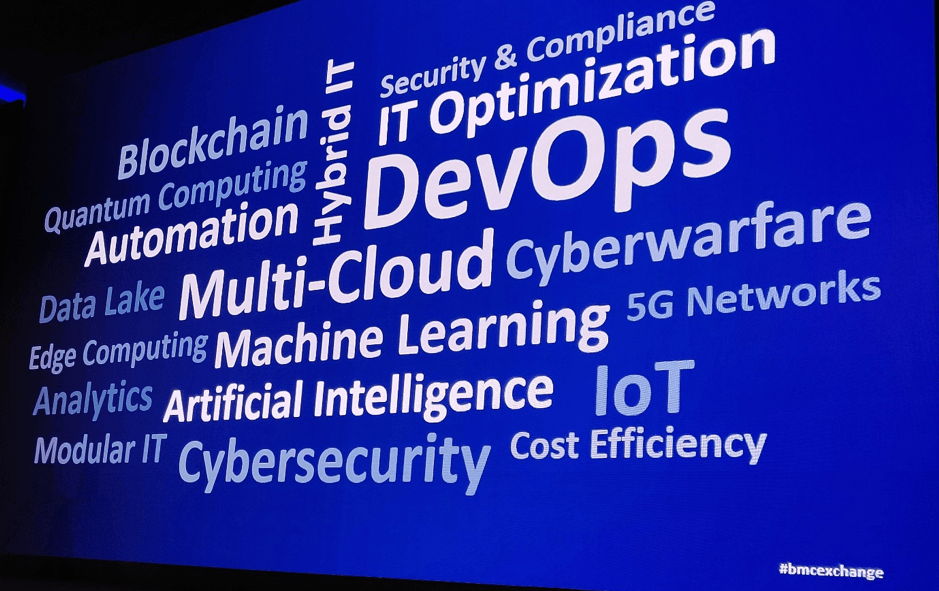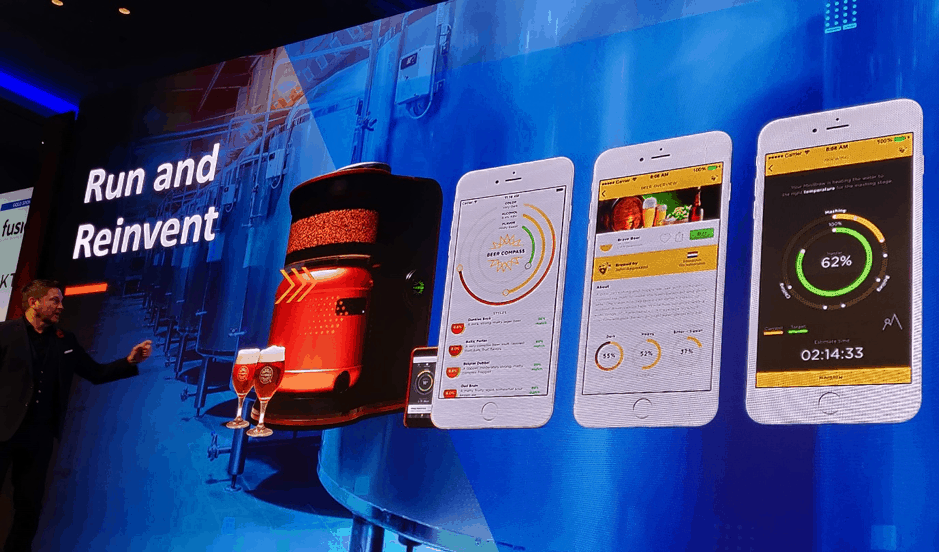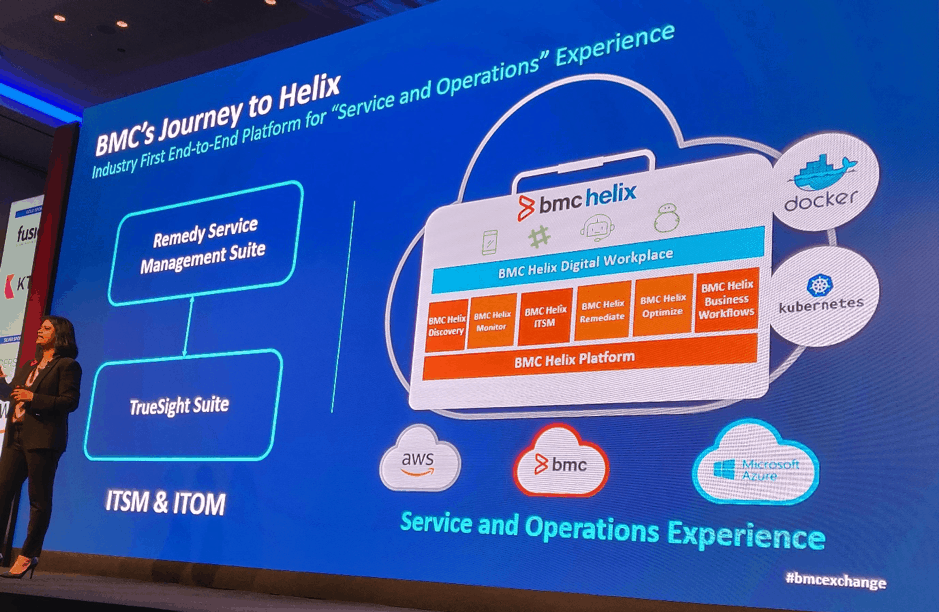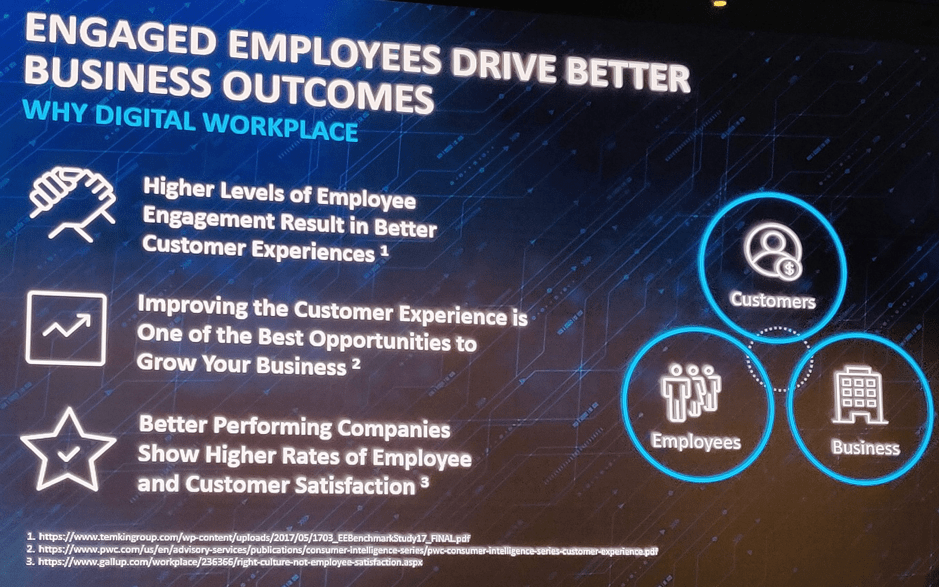IT service management (ITSM) tool vendor customer events can be great places to pick up new information and knowledge about the current and future states of the industry. From the immediate challenges and successes of organizations, through the technologies and capabilities being added to ITSM tools, to the distillation of the many IT industry analyst predictions affecting IT service delivery and support. We all love to hear about future ITSM capabilities.
This year’s BMC Exchange in London was no exception – in fact, it was a really worthwhile event to attend – and this article shares some of the information nuggets and tips that I picked up during the day.
A few interesting statistics and information drops
To start, it’s not a list (for a change) but a good old-fashioned word cloud on the key IT if not future ITSM capabilities. Here are some of the technology-related opportunities and issues that organizations need to consider both now and looking forward:

You’ll notice that machine learning and artificial intelligence (AI) are both large and central in the image, with this unsurprising given the shared statistic that: “63% of IT leaders are investing in AI and machine learning.”
You might also be thinking “Where’s a digital transformation in all this?” It was definitely a theme running throughout the event, along with BMC’s own “run and reinvent,” with a great example provided by @JasonAndrewBMC – an app-driven, coffee-machine-like, home brewing device that’s a disruption for the brewing industry.

Another interesting digital transformation example of future ITSM capabilities was provided by BMC customer @Cargill. It can tell from data related to the movement of shrimps’ legs whether the shrimps’ food mix and/or volume need to be changed.
Both of which are probably not two examples that you’d immediately think of when talking about digital transformation.
Finally, before I get to the tips to improve your future ITSM capabilities, if you’re like me then you love ITSM-related statistics. These from @vidsus were worth capturing and sharing:
- 59% of CIOs think that growing IT complexity is leading to more outages
- 66% of CIOs think that existing monitoring solutions identify less than half of all performance issues or outages.
Both are important when we stop to think about the adverse impact of adding even more technology to the business ecosystem and how good we are at managing the services that rely on it.
7 tips to improve your future ITSM capabilities
Here are seven tips for future ITSM capabilities picked up at the event:
- “Modern business is very much about how we use our data” ~ @JasonAndrewBMC. If your ITSM organization is “in the majority,” it has a wealth of data trapped within its ITSM tool(s) and other systems. So, what are you going to do about it? AI adoption should be a gamechanger here, with data exploitation driving better decisions and business outcomes.
- “Like bikers on corners, businesses want to go as fast as they can but not any faster” ~ @saarshwartz. It’s a great point that, while we’re very much focused on speed (or velocity), there’s a need to balance speed and risk to ensure that operations and outcomes are optimized in a safe way.
- “Technology is the driver of change AND the thing being changed” ~ @Nayaki_N. For me, this is a great statement and a point that can be easily overlooked. It’s easy to dwell on both sides of this sentence in isolation, maybe even flipping between the two perspectives. But how often do we fully take both sides into consideration? I’ll leave this one with you.
- Remember what the business truly needs of IT (and ITSM). Clue: it’s not simply technology. @vidsus defined three important areas of business impact: giving users a better experience, finding efficiencies, and growing new business.
- Understand the key drivers of (the need for) change and future ITSM capabilities. BMC highlighted five key driving forces:
- The changing workforce – multi-generational workforces with different needs
- Consumerization of the enterprise – the need to meet the technology expectations of today
- Intelligent automation – the leveraging of AI
- Complexity – with more data, higher expectations, and lower budgets
- Disparity – thanks to disparate tools and systems.
- “Swarming offers a more effective alternative to tiered (IT) support” ~ @JonHall. It’s something that’s now included in both ITIL 4 and VeriSM and changes support operations from being:
Tiered support Swarming Siloes and hierarchies Network Directed Collaborative Linear, rigid Dynamic, loopy Measured on activity Measured by value creation
If you Google “Jon Hall and swarming,” he’s written and presented a lot about what it is and how it helps. - “If you want to understand someone’s true character, see them in a stressful situation. You only need to get them cold, wet, tired, and hungry” ~ @astro_timpeake. OK, it might be a bit extreme for when you’re recruiting new IT support or wider ITSM staff, but the point is still valid. While an interview situation might be stressful for some, consider adding something “unexpected” (and I don’t just mean a left-field question) that allows you to better ascertain how candidates react and perform when faced with an unwanted interruption to “business-as-usual.”
BMC’s big ITSM announcement
BMC used its London event to drop the news that BMC Helix now combines ITSM and IT operations management (ITOM) capabilities. You can read the detail in the BMC Helix press release here. To quote that, it’s a: “Unified platform for ITSM and ITOM to discover, monitor, service, remediate, and optimize IT landscape, enriched with pervasive intelligence to turn unknowns to knowns, and deliver a consumer grade experience to the enterprise.”
It will be interesting to hear of the customer successes at next year’s event.

Future ITSM capabilities will focus on employee experience and productivity
This wasn’t a BMC statement but, looking at my photos of slides from BMC Exchange London as I wrote this, I felt compelled to share this slide because of its title.

So much of what we need to do in terms of future ITSM capabilities, using much of what is mentioned in this article, needs to be focused on making employees more productive. Because, while we might be talking about employee experience or employee engagement, ultimately ITSM has a big role to play in ensuring that technology helps in terms of employees “being able to make progress every day toward the work that they believe is most important.”
So, that’s some of what I took away from the BMC Exchange London event. What else would you have expected to hear about in terms of future ITSM capabilities? Please let me know in the comments.
Would you like to read an article on getting the latest Gartner ITSM Magic Quadrant for free?
Stephen Mann
Principal Analyst and Content Director at the ITSM-focused industry analyst firm ITSM.tools. Also an independent IT and IT service management marketing content creator, and a frequent blogger, writer, and presenter on the challenges and opportunities for IT service management professionals.
Previously held positions in IT research and analysis (at IT industry analyst firms Ovum and Forrester and the UK Post Office), IT service management consultancy, enterprise IT service desk and IT service management, IT asset management, innovation and creativity facilitation, project management, finance consultancy, internal audit, and product marketing for a SaaS IT service management technology vendor.

